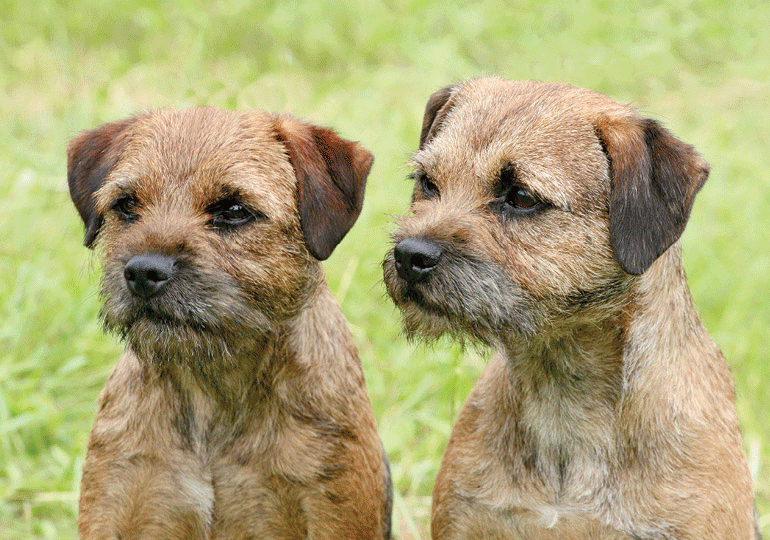
GROUP 2 - TERRIERS
The Border Terrier originated in the rugged country along the borders between Northumberland, England and Scotland. Their work with Foxhounds means they were bred to cover long distances over rugged terrain.
Border Terriers have always been bred for their working abilities, primarily to bolt foxes. The breed’s keen, game nature, as well as its racy structure and lithe appearance, makes it suitable for this activity.
The dog’s size is particularly important for this work. As with other Earthdog breeds, a Border Terrier needs to be small-bodied enough for an average-sized man to reach both hands around its body behind the shoulders, so that it can follow a fox underground.
Although the breed was first shown in the 1870s, the first Border Terrier wasn’t registered with the Kennel Club until 1913, and the breed gained official recognition in 1920.
In Australia, the first recorded owner of a Border Terrier was Mrs Russell from Melbourne in the mid 1940s, while NSW’s first Border Terrier was imported from the UK’s Solway Kennels by George Sheaves in the early 60s. That dog went on to become a champion, handled by John Ellem.
Sociable, game and active, the Border is often described as a big dog in a small body. It is agile, intelligent and generally obedient, and still maintains its working character.
They are a handy size and suitable for the show ring as well as canine sports such as Agility, Obedience, Flyball, Tracking and Earthdog, and some have achieved their endurance titles. Alternatively, they make good pets and wonderful companions.
A thick, loose skin (or pelt) protects them from attacking foxes and helps them to be able to turn around when underground without injury. Their double coat, with harsh outer coat and soft undercoat, also makes them hardy, and needs hand stripping only twice yearly to maintain. For the show ring, the coat is stripped and neatened but not overly groomed, clipped or scissored.
They are described as having a head like an otter. That is, a flat skull, a shallow but well defined stop and strong muzzle combine to resemble an otter’s head. A sound breed, the Border Terrier should be athletic and agile, with efficient movement. Weighing between five and seven kilos, it is not heavy for its size.
Vital Statistics:
Head and skull: head like that of an otter. Black nose preferable, but liver or flesh coloured one not a serious fault.
Eyes: dark with keen expression.
Ears: small, V-shaped. Of moderate thickness, and dropping forward close to the cheek.
Mouth: scissor bite, with upper teeth closely overlapping lower teeth and set square to the jaws. Level bite acceptable. Forequarters: forelegs straight, not too heavy in bone.
Body: deep, narrow, fairly long. Ribs carried well back, but not oversprung. Loins strong.
Feet: small with thick pads.
Tail: moderately short, fairly thick at base, then tapering. Set high, carried gaily, but not curled over back.
Gait: has the soundness to follow a horse.
Coat: harsh and dense, with close undercoat. Skin must be thick. Colour: red, wheaten, grizzle and tan, blue and tan.
Size: dogs 6-7kg, bitches 5-6.5kg.
A type of epilepsy, Canine Epileptoid Cramping Syndrome, has been observed in the breed, and there is currently no genetic testing available. Breeders are aware of this problem and do their best to minimise its incidence in the breed by removing affected dogs from breeding programs.
A relatively hardy breed, the Border Terrier needs little veterinary attention and regularly lives to 15 years of age.
The Border Terrier is particularly suited to families, with every member benefiting from its company, as well as to anyone involved in all the canine endeavours outlined above.
Words: Pamela Harding
Images: Two Border Terriers + Border Terrier on grass - Shutterstock.com
Now you know a little about the Border Terrier, you may think that this is the dog for you. Before you make a decision, please make contact with the breed club or your State controlling body for purebred dogs. They will be able to give you information about available puppies and also suggest dog shows where you can see the breed and speak to breeders. In this way you will gain a better perspective of the Border Terrier and its needs, and whether this breed would suit your lifestyle.